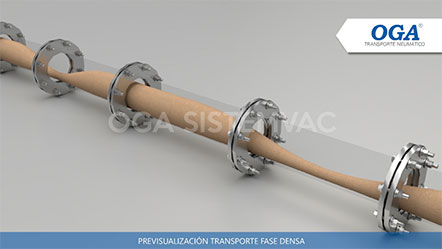
Choosing the right pneumatic transport systems for your company brings with it a series of considerations to take into account; among them the type of materials to be transported, storage process, packaging, supervision and control of industrial processes.
Knowing these aspects will allow you to make a selection of a complete transport system that gives you safety and quality in the productive results of your company.
Our expertise of more than 24 years in the design, manufacture and installation of pneumatic transport systems in the world we want to share some important factors that must be validated when selecting a system suitable for the objectives of your company.
PROJECT JUSTIFICATION: Occasionally this factor is not very clear at the beginning of the evaluation of the implementation of a MATERIAL HANDLING system, it is decisive to define the justification of why to think of a pneumatic system, which will be its benefit in the process of production to intervene (savings, flexibility, tightness, elimination of pollution, ergonomics, industrial safety, etc.) with this clarity the solution to be raised can be focused to cover the needs that will finally justify an eventual investment. The question that should always be resolved before who makes the implementation decision is: what is the direct benefit of this implementation and what savings does it generate for the company for its installation and operation?
DEFINITION OF THE SCOPE: once the previous item has been defined, the system to be considered for SOLID MANAGEMENT, it is equally important to focus the system to cover the essential need and from there evaluate complementary alternatives as optional. In this type of application you can easily lose the focus of what is intended to be covered with the PNEUMATIC TRANSPORTATION SYSTEM, so they are annexed in the development of a subprocess offer that is NOT necessarily essential to comply with the justification of the project. A typical example of this situation is that SILOS are easily projected, although the process essentially does not require them, there are solutions that just by moving from bag handling to BIG BAG is enough to achieve the return on investment in an OGA system.

- DEFINITION OF TYPE OF TRANSPORTATION: Although virtually all solid products are viable to be mobilized by means of PNEUMATIC TRANSPORT SYSTEMS, the type of pneumatic transport must be correctly selected, either VACUUM TRANSPORT or BLOWED TRANSPORTATION or in DENSA PHASE or DILUTED PHASE , in the case of products that have already been mixed or of high hardness which makes them abrasive it is advisable to use TRANSPORTATION SYSTEMS BY DENSE PHASE, this because the speed inside the dense phase transport pipe is between the 5 to 10% of the speed of a DILUTED PHASE system, this prevents segregation or wear of the pipe in the system. The transport distance must also be considered, with the DENSA PHASE systems being those indicated to cover long distances or high flows of transferred material.
- MANUFACTURER’S EXPERIENCE: the proper design of pneumatic transport systems has a high degree of complexity, more than 23 variables are involved in this process, however, the success of a system is defined by 2 important variables:
a. The theory and mathematical model of selection. (fifty%)
b. The manufacturer’s experience with similar products and systems installed (50%)
OGA nowadays has more than 2,000 pneumatic transport systems installed and in operation that handle distances greater than 250m of horizontal distance, 50 vertical meters and flows up to 180 ton / h. experience that supports the success of new applications.
For more information request:info@oga.com.co




